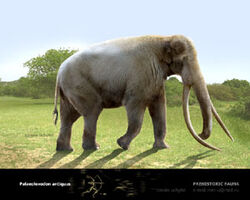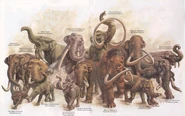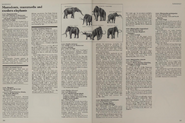| Palaeoloxodon | |
|---|---|

| |
| Straight-tusked elephant (Palaeoloxodon antiquus) | |
| Scientific classification | |
| Kingdom: | Animalia |
| Phylum: | Chordata |
| Class: | Mammalia |
| Order: | Proboscidea |
| Family: | Elephantidae |
| Tribe: | Elephantini |
| Genus: | ††Paleoloxodon Matsumoto, 1924 |
| Type species | |
| ††Paleoloxodon antiquus Matsumoto, 1924 | |
Palaeoloxodon, also known as the Straight Tusked Elephant, are an extinct subgenus of elephants, containing the various species of straight-tusked elephant. Its species' remains have been found in Bilzingsleben, Germany; Cyprus; Japan; Sicily; Malta; and recently in England during the excavation of the second Channel Tunnel. The English discovery, in northwest Kent, dated c. 400,000 ybp, was of a single adult; associated with it were Palaeolithic stone butchering tools of the type used by Homo heidelbergensis (BBC News).
Palaeoloxodon belongs to the genus Elephas and so is more closely related to the Asian Elephant than the Asian is to the two species of African elephants in the genus Loxodonta. Palaeoloxodon is known informally as the "straight-tusked elephant" because of the straight tusks of Elephas (Palaeoloxodon) antiquus. The last mainland European Palaeoloxodon faced extinction 30,000 years ago. The Japanese species survived possibly a little longer afterwards. The last straight-tusked elephants were the Mediterranean dwarf species, which died out 8,000 years ago - possibly at the hands of human hunters and introduced predators.
Description[]
Palaeoloxodon antiquus is a primitive forest elephant, and was the largest species, living in Europe until the end of the Pleistocene epoch. This ancient elephant lived in Asia and Africa during interglacial periods. Paleoloxodon was a big animal, and the size of large species of mammoth: its height at the shoulder reaches 4.3 m and Paleoloxodon weighed 10 tons. The tusks were relatively straightforward, and often more than 9 metres in length.It was obitatal in forests and woodlands that it lived in.
It ate mostly soft, herbivorous food. Mostly it was the leaves of trees. However, it is presumed that it foraged for grass and foliage. In times of glacial periods, forest elephants lived in the south, following the movements of the forest zone. In Africa, it went further north. Thus, during the Pleistocene, forest elephants migration occurred, and its area is much changed. Significant role in the extinction of these prehistoric forest elephants were probably climate change or hunting. It is possibly the largest land mammal that ever lived
Morphology[]
The belief in Cyclops may be originated in Paleoloxodon falconeri skulls found in Sicily, italy. If one does not know what an elephant looks like, the place where the trunk is placed on the skull can be mistaken for a giant eyesocket.

Mounted skeleton of Palaeoloxodon falconeri.
Species[]
Some notable species are:
- Elephas (Palaeoloxodon) antiquus (England and Germany), was twice the size of a modern African elephant
- E. (P.) cypriotes (Cyprus), dwarf elephant.
- E. (P.) falconeri (Sicily and Malta), dwarf elephant.
- E. (P.) mnaidriensis (Sicily), dwarf elephant.
- E. (P.) namadicus (Asia)
- E. (P.) naumanni (Southern Japan), dwarf elephant and possible subspecies of E. namadicus.
- E. (P.) recki (Africa)











